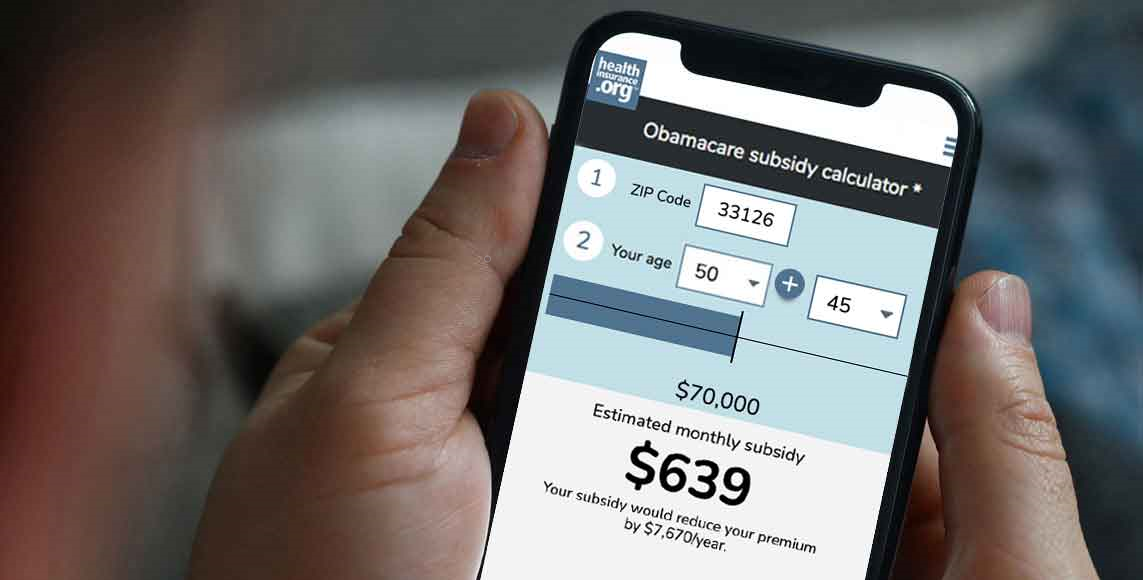
In this article
The Affordable Care Act (ACA) provides two types of subsidies for eligible individuals who enroll in individual health insurance plans through the federal and state-based exchanges:
- Advance Premium Tax Credits (APTC) – commonly referred to as premium subsidies – are available to people who aren’t eligible for Medicaid, and whose household income is at least 100% of the federal poverty level (FPL), or above 138% of FPL if they reside in a state that has expanded Medicaid. There used to be an income cap for subsidy eligibility at 400% of the poverty level, but that has been eliminated through 2025 by the American Rescue Plan and Inflation Reduction Act. Through 2025, premium subsidies are available if the benchmark plan (second-lowest-cost Silver plan) would otherwise cost more than 8.5% of the household’s income.
- Cost-sharing reductions (CSR), otherwise known as cost-sharing subsidies, are available to people who aren’t eligible for Medicaid, who purchase a Silver plan, and whose income is at least 100% of the poverty level but no more than 250% of the poverty level. (The same caveat applies regarding the lower income limit for subsidy eligibility in states that have expanded Medicaid.) When an applicant is eligible for CSR, all of the available Silver plans will have reduced cost-sharing (deductibles, copays, coinsurance, maximum out-of-pocket limits) compared with regular Silver-level plans.
Obamacare subsidy calculator *
For those already enrolled in a health insurance plan that satisfies the ACA’s minimum essential coverage requirement, an income change or a change in family size counts as a qualifying life event if it results in a change in eligibility for premium subsidies or CSR. (A qualifying life event triggers a special enrollment period.)
The specific rules for special enrollment periods (SEP), including those related to changes in subsidy eligibility, can be found at 45 CFR § 155.420.1 In general, an enrollee who becomes newly eligible or newly ineligible for subsidies has a 60-day window (starting with the date of the change in income or family size) during which they can switch to a different plan.
Option to make a plan change if you’re newly eligible (or newly ineligible) for cost-sharing reductions
People who are enrolled in a Silver plan with CSR qualify for a special enrollment period to switch to a plan at a different metal level if they become newly ineligible for CSR. This provision was finalized by HHS in 2020 and took effect in 2022.
Before that, the rules already clarified that an exchange enrollee who isn’t enrolled in a Silver plan must be allowed to switch to a Silver plan if they experience an income change that makes them eligible for CSR, assuming they wish to take advantage of CSR. However, there was not a similar provision for people who were already enrolled in a Silver plan with CSR, who then lost their CSR eligibility.
An existing provision – CFR § 155.420(d)(6)(ii)2 – already granted a special enrollment period to an enrollee who experienced “a change in eligibility for cost-sharing reductions,” but HHS clarified that the existing provision limited people to a new plan at the same metal level they already had – hence the need for a new rule allowing people to switch from Silver to a different metal level if they lose their eligibility for CSR benefits.
The new rule was added as subsections of CFR § 155.420(a)(4)(i), addressing people who are newly ineligible for CSR as well as those who are newly eligible for CSR. Those who are newly eligible for CSR can switch to a Silver plan. Those who are already enrolled in a Silver plan with CSR benefits and then become newly ineligible for CSR can switch to a Bronze or Gold plan if they wish to do so.3
An option to make a plan change if you’re newly eligible (or newly ineligible) for premium subsidies
The exchanges must allow people who lose their eligibility for advance premium tax credits to switch to a different plan at any metal level (or a catastrophic plan, if they’re eligible for one) if they choose to do so. This is clarified at § 155.420(a)(4)(ii)(C).1 The rule was finalized in May 2021,4 but exchanges had until January 2024 to implement it.
Loss of advance premium tax credits (i.e., becoming ineligible for premium tax credits mid-year) can happen due to an increase in income, or due to a decrease in household size (for example, a household of four becomes a household of three when an older child ceases to be a federal tax dependent).
If a person becomes newly eligible for premium subsidies due to a decrease in income or an increase in household size, they will qualify for a special enrollment period during which they can pick a different plan. But the new plan has to be another plan at the same metal level as their current plan (unless there are no other plans available at that metal level, in which case the person can choose a plan up or down one level — but that’s a rare scenario; in 2024 the average HealthCare.gov enrollee can choose from among 31 Bronze plans, 38 Silver plans, and 28 Gold plans5).
HHS addressed this issue in the proposed rule changes for 2022, and noted that they decided against a rule change to add additional flexibility to switch to a plan at a different metal level in a situation where a person becomes newly eligible for premium tax credits (see page 177). The flexibility to switch metal levels is only applicable if the person becomes newly ineligible for advance premium tax credits.
(Note that there are other SEPs for people who get out of the coverage gap in states that haven’t expanded Medicaid, or gain a dependent. Both of these are scenarios in which a person is or might be newly eligible for subsidies. But these scenarios have their own applicable rules.)
Plan changes for off-exchange enrollees with an income change that makes them subsidy-eligible
Federal regulations (eCFR 45 § 147.104(b)(2)(i)(B))6 allow people who lose eligibility for premium subsidies to switch from an on-exchange plan to an off-exchange plan. Giving people the flexibility to switch from on-exchange to off-exchange when they lose eligibility to premium subsidies may be particularly helpful now that insurers in most states are taking the cost of CSRs into account when setting Silver plan premiums in the exchange, but offering off-exchange Silver plans without the cost of CSR added to their premiums.7
(This makes the off-exchange versions of Silver plans cheaper for a person who isn’t eligible for premium subsidies. But if the person becomes eligible for premium subsidies they may find that they can obtain less expensive coverage by utilizing the subsidies, which are only available on-exchange.)
The SEP for people who have off-exchange coverage and experience an income change that makes them subsidy-eligible was formalized in the 2020 Notice of Benefit and Payment Parameters that HHS finalized in April 2019. Here are the details:
- HHS added a new section at § 155.420(d)(6)(v)1 describing the new SEP.
- The SEP is available in all states that use HealthCare.gov (including state-run exchanges that use the federal enrollment platform).
- The SEP is optional for state-run exchanges to offer (DC and 18 states have state-run exchange platforms as of 2024).8
- Consumers who qualify for the SEP have 60 days from the date of their income change to enroll in a plan through the exchange.
- If other members of the person’s household are already enrolled in a plan through the exchange, the person with a SEP will be allowed to join them on that plan. Alternatively, the person will be allowed to enroll in a separate plan of their own choosing during the SEP.
- Consumers taking advantage of the SEP have to provide proof of their income change, as well as proof that they had minimum essential coverage (or pregnancy Medicaid, CHIP unborn child, and Medically Needy Medicaid) before the income change (for at least 1 of the 60 days prior to the income change, as is standard with other SEPs that require proof of prior coverage).
- Off-exchange minimum essential coverage includes ACA-compliant plans that are sold outside the exchange, but it also includes grandmothered and grandfathered plans (Learn more about grandfathered plans.) So a person who has retained one of these plans – maybe because they weren’t eligible for subsidies – can switch to an on-exchange ACA-compliant plan with premium subsidies in the future if they have an income change mid-year that makes them subsidy-eligible.
- However, plans that are not minimum essential coverage, including short-term health plans, will NOT satisfy the prior coverage requirement for this SEP. So a person who enrolled in a short-term health plan would not be eligible for a SEP to switch to an on-exchange plan mid-year if they experience a change in income.
- As is always the case when people switch from one plan to another mid-year, out-of-pocket amounts will start over at $0 on the new plan (unless the enrollee is switching to the exact same plan on-exchange that they already have off-exchange, and the insurer agrees to credit their out-of-pocket spending towards the new plan; there is nothing that requires insurers to do this, but it doesn’t hurt to ask).
From 2014 through 2019, the SEP triggered by an income change only applied if the person was already enrolled in a plan through the exchange. If you were enrolled in an off-exchange plan, you were not eligible for a SEP if your income changed mid-year.
This made it challenging for some people to take advantage of the “Silver switch” option that many states have offered as a solution to the cost of CSR. People who aren’t eligible for premium subsidies – but who want a Silver plan – may find that the full-price cost of the plan is lower if they shop outside the exchange. But then if they experienced a change in income mid-year that made them eligible for a subsidy, they were still stuck with their full-price off-exchange plan until the following year.
Income changes and job changes can sometimes be difficult to predict, but from 2014 through 2019, neither of those counted as a qualifying life event if you weren’t already enrolled through the exchange.
In finalizing the SEP that allows off-exchange enrollees to switch to the exchange, HHS noted that people enrolled in employer-sponsored coverage or exchange coverage who become newly eligible for premium subsidies on the exchange will have an opportunity to take advantage of those subsidies when they experience a change in income, as do uninsured people in the states that haven’t expanded Medicaid and fall in the coverage gap.
But before 2020, there wasn’t an opportunity for people enrolled in off-exchange coverage to take advantage of a premium subsidy for which they are newly eligible. The updated rules changed that, starting in 2020.
Subsidies are only available in the exchange, but if you’re not subsidy eligible, it’s worth looking at both on-exchange and off-exchange options..
Louise Norris is an individual health insurance broker who has been writing about health insurance and health reform since 2006. She has written dozens of opinions and educational pieces about the Affordable Care Act for healthinsurance.org.
Footnotes
- “§ 155.420 Special enrollment periods” ECFR.gov. May 10, 2024 ⤶ ⤶ ⤶
- “§ 155.420 Special enrollment periods” ECFR.gov. May 10,2024 ⤶
- “CRF § 155.420 Special enrollment periods” Code of Federal Regulations. Accessed January 2024 ⤶
- “Patient Protection and Affordable Care Act; HHS Notice of Benefit and Payment Parameters for 2022 and Pharmacy Benefit Manager Standards” federalregister.gov. May 5, 2021 ⤶
- “Plan Year 2024 Qualified Health Plan Choice and Premiums in HealthCare.gov Marketplaces” Centers for Medicare & Medicaid Services. Oct. 25, 2023 ⤶
- “eCFR 45 § 147.104 Guaranteed availability of coverage, Subsection (b)(2)(i)(B)” Code of Federal Regulations. Accessed April 11, 2024 ⤶
- “Considerations for Calculating CostSharing Reduction Load Factors” American Academy of Actuaries. Nov. 16, 2022 ⤶
- “State Health Insurance Marketplace Types, 2024” KFF. Accessed April 11, 2024. ⤶








